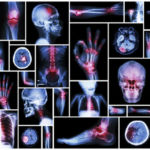[CW: The following article is for an adult audience due to its content and language. We are sharing challenges related to having sex and ways of overcoming those with concrete examples.]
For our August newsletter, the Chronic Pain Partners media team brought together people from the EDS community and medical professionals to share their opinions about a topic that’s often ignored and rarely openly spoken about: the sexual health of people with Ehlers-Danlos syndromes. Journalists Jackie Saa and Karina Sturm spoke with Mary Cordaro, admin of the “Sex-tacular EDS Zebras” group on Facebook, Sarah Cook, Physician Assistant, and Dr. Susan Delaney, MD and sex therapist, about gynecological and other problems that complicate having sex and how to overcome those barriers.
Let’s clarify one common misconception right at the start: Yes, people with chronic illnesses and disabilities do have sex. The common belief that disabled people cannot or do not want to be intimate is deeply rooted in our society, but this couldn’t be further from the truth. However, people with Ehlers-Danlos Syndrome may face varying physical or mental barriers depending on how the condition presents for every individual, preventing them from having the desired sex life [see box 1].
|
Box 1: Potential physical and mental issues related to sexual health in people with EDS (References used for this box are at the end of the article)
2. Issues for individuals born with internal reproductive organs:
3. Issues for individuals born with external reproductive organs:
|
Oftentimes, medical professionals don’t offer the space to talk about sexual health – it’s not their priority with all the other issues a person with EDS might have – so where to turn to for support? Mary Cordaro wanted to change this and created a group on Facebook called Sex-tacular EDS Zebras, where people with EDS can share their concerns with members of the community who understand and will not judge. “There weren’t any groups where people could openly talk about sex. There weren’t groups where men were welcome too. One of our moderators is gay; one is gender-fluid. We really wanted to create more diversity in EDS support groups. Our group is welcoming to everyone from the EDS community,” Cordaro, the admin of the group, says. “We have a zero-tolerance policy, which means no bullying or belittling is ever tolerated.” She built the group not only to create a safe space for all people in the EDS community to share their challenges and victories with sex, intimacy and wellness but also to find support herself because Cordaro knows all those issues from personal experience.
“For a long time, my EDS symptoms stole my sex life. I was angry that I wasn’t enjoying sex and that the sex had stopped. I wanted to enjoy sex. Then, I decided I had to figure out what I need from sex to actually have a sex life,” she explains. “So sex has become the positive reinforcement for my body that makes all the rest of my care possible. I learned to see my body in a positive light, despite pain. And when I say sex, I mean intimacy; I mean closeness.” Some people with EDS are quite creative in finding solutions for whatever barrier they are facing by themselves; others utilize the advice in support groups online. However, if those aren’t enough, one may also benefit from the experience of a certified sex therapist.
“A sex therapist can help a couple to improve the quality of their sex life. Sometimes there’s a conflict between the couple. One of them might want sex a little more often than the other one, and I help them to negotiate a compromise,” Susan Delaney, a board-certified psychiatrist and sex therapist in Texas, says. Delaney has supported many couples where one partner had a chronic illness and/or disability. Additionally, she has also 45 years of experience in treating anxiety and depression. Like Cordaro, people with EDS may avoid sex because it could cause pain from dislocating a joint or from gynecological complications of EDS (see box 1). “Many discussions in our group focus on general gyn issues in the EDS population that can affect sex, like organ prolapses and incontinence,” Cordaro shares. “But there are also a lot of people who experienced abuse; many have trauma related to unsupportive family members. Some have been sexually repressed.”
For people who have experienced as much trauma as persons with EDS – whether that’s from sexual assault, medical trauma or something else – it’s all about trust and generating this environment where one can communicate openly. In terms of sex therapy, Delaney creates that trust by using a technique called mirroring. “When a patient calls me to set up an appointment, I write down everything they say. And at the time of the first appointment, I am reading it back to them and ask them if it all is correct. Then they usually relax,” Delaney explains. Once she has established a good relationship with her patients, she starts with a several-step strategy the couple has to work on together, which, ultimately, focuses on trust and communication as well. “The first homework assignment is designed to get the couple to talk about touch. I have them touch every square inch of their bodies – there are no breasts or genitals involved – to find out where the person likes to be touched,” Delaney says. She calls this getting a PhD in the other person’s body. “In my 45 years of practice, I have never met a couple that likes the same kind of touch, and that’s very important, because as people get closer and closer to orgasm – if that’s going to happen – they start doing what they like, not what their partner enjoys,” Delaney shares. For people with EDS, touch might be painful in certain areas of the body, so it is crucial to find those parts where they don’t hurt but can relax and enjoy being touched. “Then for the second assignment, they do the same things, but this time, it includes breasts and genitals,” Delaney elaborates.
|
Box 2: Dr. Delaney’s strategy for sexual wellness
|
According to Delaney, a couple should also plan their sexual encounters ahead of time. In order to create a romantic atmosphere on the day of the appointment, candles and flowers could be involved, too. And all distractions should be avoided, like too much alcohol or texting during sex (see Box 2). “By setting up an appointment and bringing flowers, for instance, we create a conditioned response, where one partner reacts to the actions of the other,” Delaney explains. “Part of this ‘conditioned response’ is that relaxing atmosphere and the open communication and knowing it’s going to be OK. That helps with reducing expectations of pain, for instance”, Sarah Cook, a physician assistant and medical writer who lives with EDS herself, adds. And pain seems to be a common issue preventing people with EDS from having a fulfilling sex life. According to Cook, the most common problem is pelvic floor relaxation dysfunction. “This can be treated by target trigger point massage,“ Cook advises. “A tool called a pelvic wand can achieve this and helps with dyspareunia, which is pain with penetration, or vulvodynia, which is pain at the opening to the vagina.”
Moreover, a partner can help to overcome some of the challenges as well by simply listening to what a person with EDS can or cannot do. “A partner can be cognizant. For example, they can notice when your head is banging into the headboard or if they are hurting one’s rib cage with their weight. I guess ultimately, what it comes down to is their receptiveness to trying something else and letting go of expectation,“ Cordaro shares.
|
Box 3: What EDSers and their partners can do to improve their sex lives:
|
Even if all of these strategies don’t help because the person with EDS cannot have penetrative intercourse due to pain, there are many other options. “Obviously, there is a lot of sexual activity that does not involve penetration. There are other places on the body where one can create the same kind of pressure and sensation for a partner but doesn’t involve the pain from penetration.”
So yes, having sex is likely more challenging when one has EDS. However, people with EDS are known to be very resilient and creative in the ways they adapt their lives around their symptoms. The same applies to problems with sexual health. Communication, trust, lots of research, a partner that listens and relates, and flexibility seem to be the key points in working through and overcoming those hurdles. Speaking of flexibility… To end this on a more positive note, hypermobile joints indeed cause many issues, but flexible joints – if they do not hurt – may be quite interesting and fun, too!
By Jackie Saa, Sarah Cook & Karina Sturm
References for Box 1:
- Lumley, M.A., Jordan, M., Rubenstein, R., Tsipouras, P. and Evans, M.I., 1994. Psychosocial functioning in the Ehlers‐Danlos syndrome. American Journal of Medical Genetics, 53(2), pp.149-152.
- Jacobs, J.W.G., Cornelissens, L.J.M. and Veenhuizen, M.C. eds., 2018. Ehlers-Danlos syndrome: a multidisciplinary approach. IOS Press. pp.290.
- Hugon-Rodin, J., Lebègue, G., Becourt, S., Hamonet, C. and Gompel, A., 2016. Gynecologic symptoms and the influence on reproductive life in 386 women with hypermobility type Ehlers-Danlos syndrome: a cohort study. Orphanet Journal of Rare Diseases, 11(1), pp.1-6.
- Handa, V.L., Cundiff, G., Chang, H.H. and Helzlsouer, K.J., 2008. Female sexual function and pelvic floor disorders. Obstetrics and gynecology, 111(5), p.1045.
- Hurst, B.S., Lange, S.S., Kullstam, S.M., Usadi, R.S., Matthews, M.L., Marshburn, P.B., Templin, M.A. and Merriam, K.S., 2014. Obstetric and gynecologic challenges in women with Ehlers-Danlos syndrome. Obstetrics & Gynecology, 123(3), pp.506-513.
- Gilliam, E., Hoffman, J.D. and Yeh, G., 2020. Urogenital and pelvic complications in the Ehlers‐Danlos syndromes and associated hypermobility spectrum disorders: A scoping review. Clinical genetics, 97(1), pp.168-178.
- Bennett, S.E., Walsh, N., Moss, T. and Palmer, S., 2021. Understanding the psychosocial impact of joint hypermobility syndrome and Ehlers–Danlos syndrome hypermobility type: a qualitative interview study. Disability and Rehabilitation, 43(6), pp.795-804.
- Minatogawa, M., Unzaki, A., Morisaki, H., Syx, D., Sonoda, T., Janecke, A.R., Slavotinek, A., Voermans, N.C., Lacassie, Y., Mendoza-Londono, R. and Wierenga, K.J., 2021. Clinical and molecular features of 66 patients with musculocontractural Ehlers−Danlos syndrome caused by pathogenic variants in CHST14 (mcEDS-CHST14). Journal of Medical Genetics.
- Cuckow, P.M., Blackhall, R.J., Mouriquand, P.D., 1994. Huge bladder diverticula associated with Ehlers-Danlos syndrome. J.R. Soc Med, 87(5), pp.290-291.
- Gabrjella Giro, M., Duvic, M., Smith, L.T., Kennedy, R., Rapini, R., Arnett, F.C., Davidson, J.M., 1992. Bushke-Ollendorff syndrome associated with elevated elastin production by affected skin fibroblasts in culture. Journal of Investigative Dermatology, 99(2), pp.129-137.
- Biebel, M., Rodriguez, D., Pan, S., Vanni, A., Munarri, R., Case – Penile fracture in a patient with Ehlers-Danlos syndrome. Canadian Urological Association Journal, 14(1), pp.39-41.
- Johansen, H., Velvin, G., Kerstin, F.M. and Lidal, I.B., 2021. Adults with Loeys-Dietz syndrome and vascular Ehlers-Danlos syndrome: A cross-sectional study of life satisfaction. Journal of Rehabilitation Medicine, 53(11).
- Kciuk, O., Li, Q., Huszti, E. and McDermott, C.D., 2022. Pelvic floor symptoms in cisgender women with Ehlers–Danlos syndrome: an international survey study. International Urogynecology Journal, pp.1-11.



